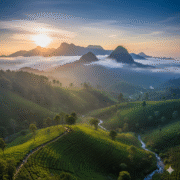
The King, the Law and the Courts – a Glimpse into Sri Lanka’s Ancient Governance
- November 14, 2025
- eunoialankatours
- 9:38 pm
Sri Lanka’s story of kingship stretches back over two millennia. Before colonial rule, the island was governed by monarchs who held a centralised form of power. In the modern republic these powers are divided among the legislature, executive and judiciary, but under the ancient monarchy the king embodied all three institutions. He was the law-maker, the administrator and the final arbiter of justice. Royal proclamations, often carved in stone, laid down legal rules informed by Buddhist ethics and local customs, and these edicts were followed by the kingdom’s judicial administrators.
A monarchy guided by the Dhamma
From the time Buddhism was introduced to the island in the third century BCE, the Sangha (Buddhist monastic community) played a formative role in governance. Kings derived legitimacy from being custodians of the Buddha’s teaching and from their patronage of monasteries. In return, monks counselled rulers and even guided state policy. The Tooth Relic in Kandy, which symbolised the rightful sovereignty of the Sinhalese monarch, was guarded by the clergy and served as a key source of legitimacy. Kings therefore could not act arbitrarily; they were expected to consult their advisers and respect Buddhist moral principles.
How justice worked
Although the monarch was the supreme judge, everyday cases were heard by a network of judicial officers. Viniccayamacca (chief judicial officer) presided over the judiciary and was assisted by several Vinicchayaka, lower-ranking judges. Provincial governors and village elders could also issue judgments. In the early Anuradhapura period, village assemblies of elders dispensed justice, and towards the end of the period groups of ten villages (dasagam) took on this role. Punishments were not uniform; they depended on the character of the reigning king. Some rulers were known for compassion, while others imposed harsher sentences, and crimes such as treason or murder could be punished by death. In cases involving members of the royal family or high dignitaries the king personally decided the outcome, usually after taking advice from his council.
Taxes and the royal treasury
Maintaining this extensive administration required resources. Land and water taxes were the principal revenue streams. During the Anuradhapura kingdom the bojakapati or grain tax was levied on cultivated land, while a dakapati water tax was collected for using water from reservoirs. Customs duties were imposed at ports, and those unable to pay in cash were expected to contribute labour by repairing reservoirs. The king’s treasurer, known as the Badagarika, oversaw the collection of these taxes. Scholars note that irrigation works, whether owned by the state, monasteries or village communities, generated income in the form of water rents and fishing rights. Rock inscriptions mention both dakapati and bojakapati as forms of revenue linked to water supply. Farmers paid a water fee called diyamura; in the early Anuradhapura period this was known as dakapati, while by the later period it was called diyabedum.
The king also benefitted from trade taxes collected at toll gates and ports. Revenue from commerce helped fund monumental projects such as stupas and monasteries in Anuradhapura and Polonnaruwa and supported large monastic populations. The prosperity generated by trade and irrigation enabled ancient rulers to build and maintain an extensive network of reservoirs—nearly 30 000 tanks still dot the dry zone today—and to support irrigation-based agriculture. According to scholars, most major and minor canals and tanks built by kings were state property, and their income from water and fish yields went directly to the royal treasury.
Among the more controversial levies was maral or marala, a “death duty”. Under this system, practised in the Kandyan kingdom, one-third of a deceased person’s property passed to the state; only two-thirds went to heirs. Women in the Kingdom of Kandy were exempt from this tax, and the British colonial administration eventually abolished it, although King Sri Vikrama Rajasinha briefly revived the duty. Such taxes illustrate how royal authority extended even into inheritance and property rights.
The hydrological economy and Buddhist patronage
Sri Lanka’s ancient civilisation was built around water. The island’s dry zones relied on carefully engineered reservoirs and canals that captured rain and river flows for agriculture. Chronicles and inscriptions show that ownership of irrigation works was divided among the state, monasteries, village communities and individuals. Monasteries began receiving grants of land and irrigation facilities from about the second century BCE, and there is an inscription referring to King Vasabha donating the Upaladonika reservoir to a monastery. Villagers also built and owned small tanks, and some families even possessed private reservoirs. Revenue from these works—water rates and fishing rights—was channelled into maintenance and often to the support of monasteries. During periods of scarcity, there was a well-organised water distribution system to ensure a fair share for cultivators.
Life after the kings
The island’s monarchy came to an end with the Kandyan Convention of 1815, when the chiefs of the Kandyan kingdom ceded sovereignty to the British Crown. Under colonial rule Sri Lanka’s legal system was gradually re-structured along European lines, and after independence the modern constitution separated the legislature, executive and judiciary. Yet traces of the old order remain. Buddhism retains a special place in the constitution, and monks continue to exert influence in politics. The country’s extensive irrigation system, much of it built by ancient kings, still sustains agriculture and stands as a testament to the organisational genius of early rulers.
Conclusion
The story of king, law and judiciary in Sri Lanka is inseparable from the island’s culture and environment. Ancient monarchs drew on Buddhist ethics to govern, consulted with monks and elders, and took personal responsibility for administering justice. Taxes on land, water and trade funded ambitious irrigation projects and religious monuments, while the Sangha’s patronage and the Tooth Relic’s symbolism legitimised royal authority. Though the monarchy ended in the nineteenth century, the legacy of these early institutions continues to shape Sri Lanka’s legal and cultural landscape today.


